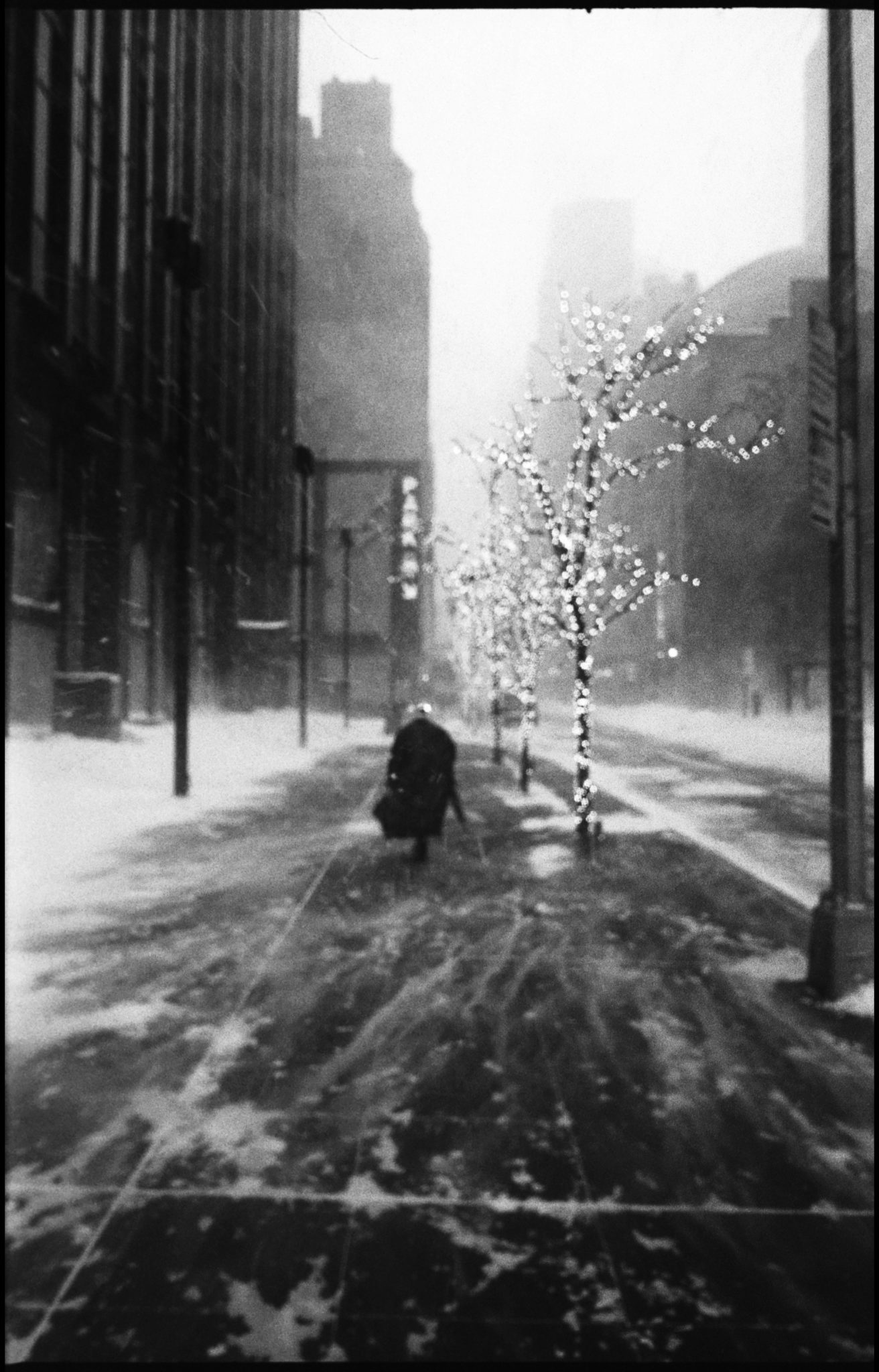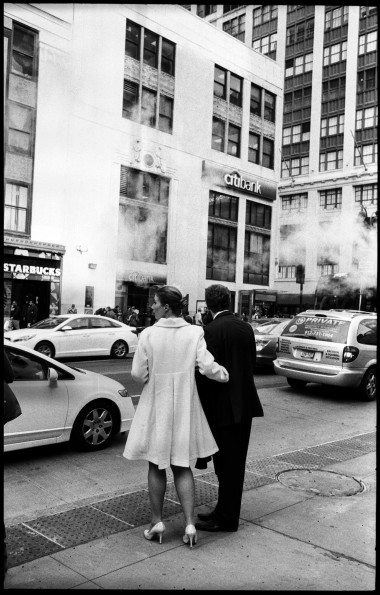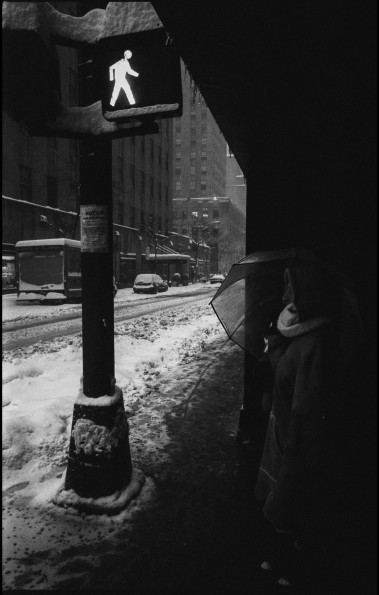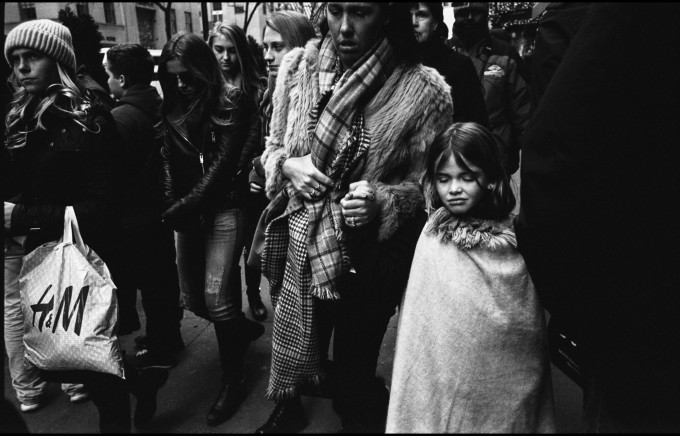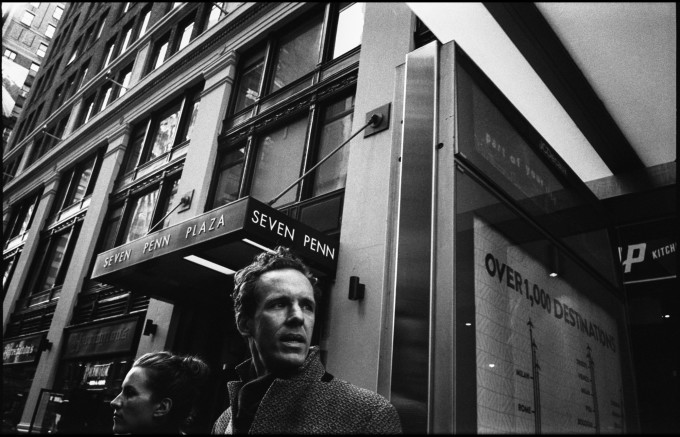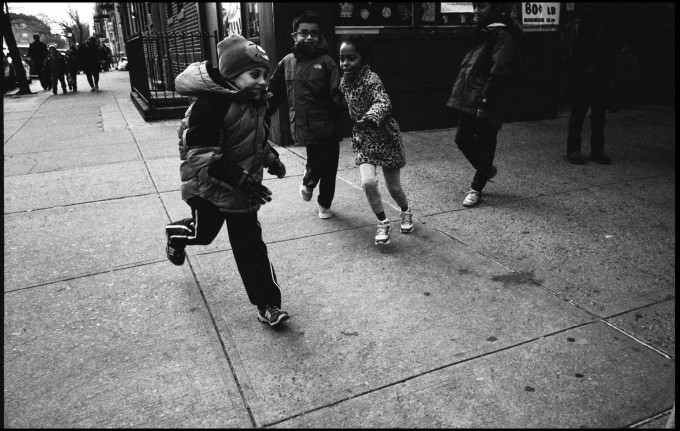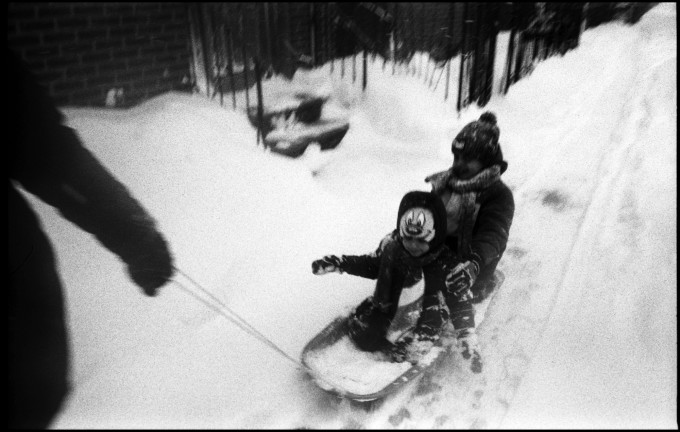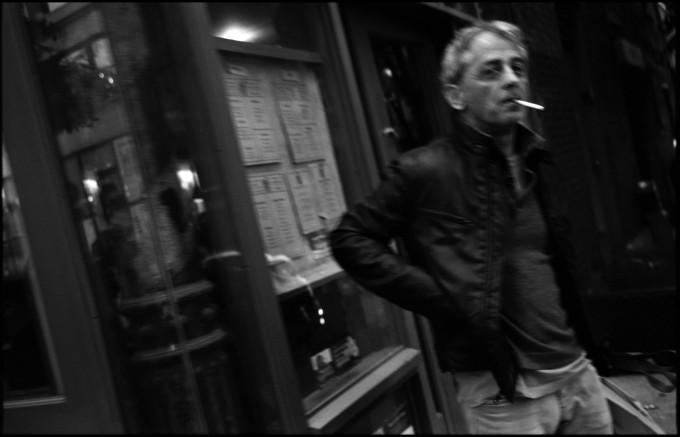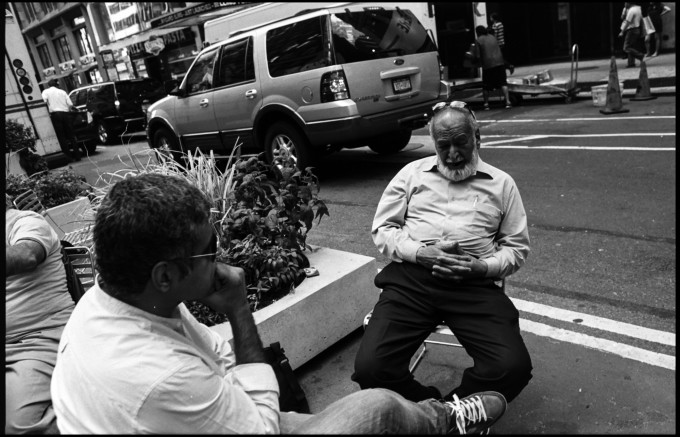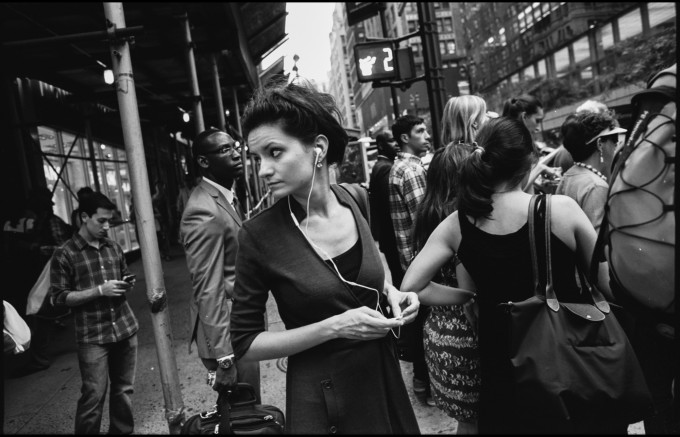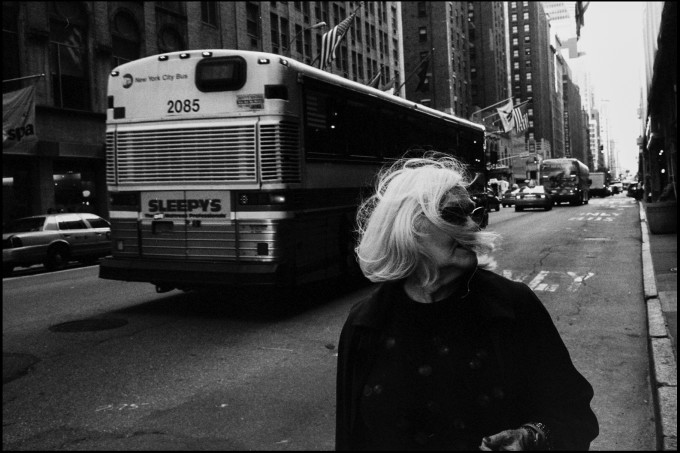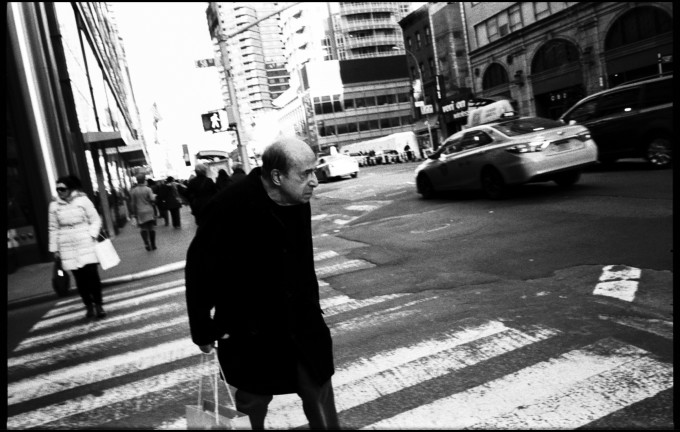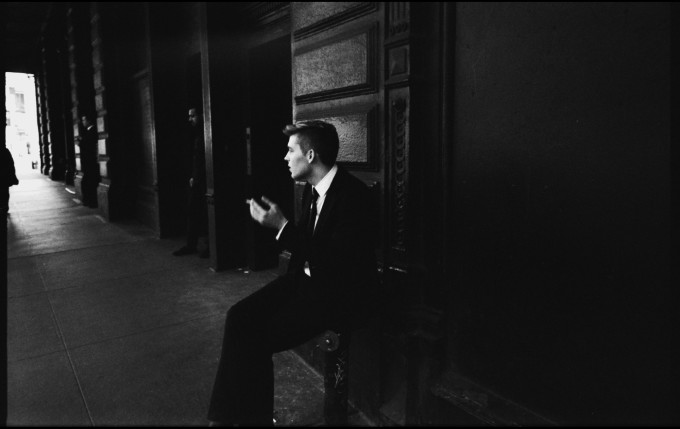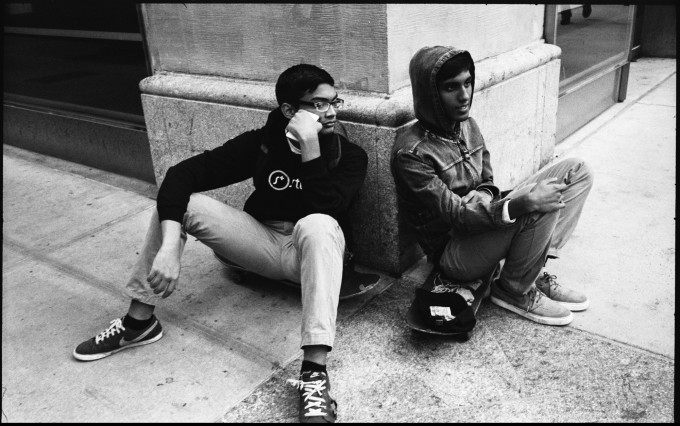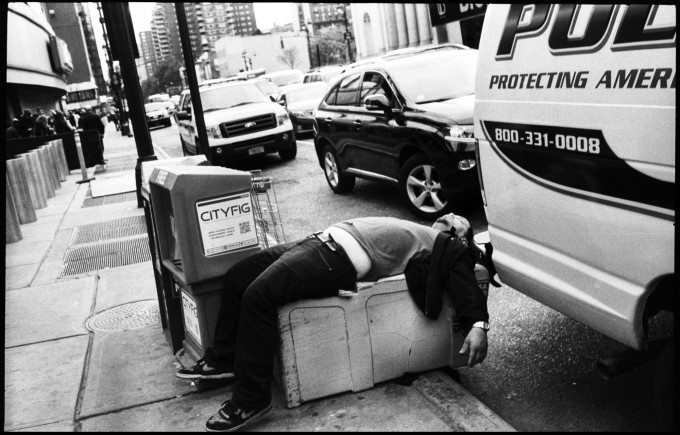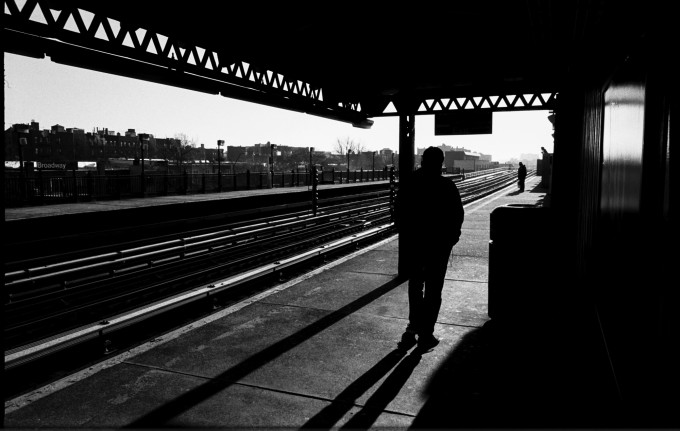All images by Justin Waldinger. Used with permission.
For a number of years now, Justin Waldinger has been out and about in NYC photographing candid moments on film. Usually sticking with Leica cameras, it took him years of nerve to finally get close enough to people to really make them the focus of the scene. Further, he’s always had a love of lots of the classic work that many photographers study.
Justin is the founder of the famous camera strap company TAP and DYE, and years ago he contacted me wanting to start the typical manufacturer/press relationship. I’ve always known of his affinity for the vintage aesthetic, but little did I know how his designer side leaked into his photographic side. I discovered this through his work presented in the CineStill Facebook group.
Even now, Justin’s work still ranks amongst my favorites of most local NYC street photographers.
Phoblographer: Talk to us about how you got into photography.
Justin: Well, my love of photography started with a love for the camera itself. My father was an avid enthusiast in his prime and even back then, was not immune to GAS (Gear acquisition syndrome). He had amassed quite a collection of beautiful mid century German and Japanese cameras, the likes of which would make any fellow gear head blush. This included but was not limited to Rollei cameras, Zeiss ikons, Yashica TLRs, Nikon and Canon rangefinders, Polaroid landcams, with the Crown Graphic 4×5 press being the holy grail. Growing up, my father was always documenting and so a camera was always within reach around the house. I was always drawn to them, the fact that they were just these beautiful mechanical objects that could capture a moment in time and record it onto a tangible proof always fascinated me.
It wasn’t until college in the late 90s early 2000s though that I actually started to use a camera on a daily basis and really took the initiative to study and learn the analog photographic process of developing and printing my work, granted it was an incredibly frustrating process for the longest time when you’re just starting out. However, once you were able to properly develop and print your work, it was just such an amazing feeling of accomplishment and joy. Most of the work I did back then was landscape based, which is what initially inspired me to get into photography from a subject matter as an amateur.
Phoblographer: What made you want to get into street photography?
Justin: Street photography was an area that I was always drawn to but found it so intimidating to really immerse myself in at first. The interest really came about later on after college while I was starting out in the design world. It grew organically as a result of searching online and frequenting Strand and Barnes & Noble sometimes during lunch breaks or after work. I would spend a few hours or so to browse though the work of the classic photographers like Kertesz, Davidson, Klein, Winogrand, Bresson, Erwitt among others and just be utterly floored by what I saw. It really struck a chord with me on a profound level, it was so inspirational and I just wanted to go out and do exactly that.
At this time, which was about 10 years ago, I was working in the Flatiron district as a product designer so I was fortunate enough to be in the city and have this abundance of material to work with so to speak. So eventually I found myself bringing along my camera, which at the time was a Nikon fe and 50mm lens with me on my daily commute to and from work. Everyday after work, I would walk up fifth avenue from 20th street to 59th and Lexington Ave just taking photos of people from a distance as I didn’t feel comfortable enough to shoot up close. That took a few years to work up honestly.
Phoblographer: You’re a man of fine aesthetics; not only is that present in your imagery but also in the work that you do heading up Tap and Dye. So when you take a photograph, what’s usually inspiring you to capture that moment? Is there usually some sort of emotion that fuels you to put the camera to your eye? Is it light? Is it geometry?
Justin: I think Winogrand said it best, “I don’t have messages in my pictures…The true business of photography is to capture a bit of reality (whatever that is) on film.” I couldn’t agree more so I always try to stay true to that mantra and do my best to capture those little moments of daily life that can go unnoticed or have an element of quirkiness to them.
Certainly though, light and geometry play an important role in the overall composition of an image but they can definitely stand firm on their own. 4 years ago, I did a street series in color where I shot in the city around the same time of day over the course of the winter months. It was in the late afternoon right when the sun was low enough in the sky to cast this amazing balance of long dramatic shadows and intense highlights. It was a very different approach to how I normally would shoot street photography. I’ve always loved the lighting and compositional elements in Edward Hopper’s paintings so this series was sort of a homage to that.
Phoblographer: You shoot lots of film, why?
Justin: I know saying this is like beating a dead horse but I just love and have always loved the way film renders…I know, I know. But honestly though I see no reason to stop shooting it. It’s just what I was brought up on and having studied the process I just have a strong bond with it. I won’t get into a film vs digital thing because that’s been done to death and in the end, it’s the photo that counts not the camera. I shoot B&W film for street work because like many, I simply love the classic look that only a black and white image can impart. It is a staple of the classic street and documentary photographers and it has defined so many important and inspirational moments in the history of not only this country but worldwide.
Seeing in black and white gets past the distraction that color can bring to a scene. It keeps you focused on what you want to document. Shooting street in color which I have done on occasion, is a whole different animal. It really challenges you to think about compositional hierarchy on a very different level, something that Alex Webb, I feel is a master at. I highly recommend getting a copy of “the suffering of light” into your hands if you want to be truly inspired by color documentary and street photography. Even if you aren’t it is still a must have in your collection.
Phoblographer: You’re a steady contributor to the CineStill facebook group; what attracts you to their film over others?
Justin: I’ve used CineStill 800 tungsten and 50 Daylight films initially because of the fact they are motion picture film stock. Having an opportunity to shoot the same Kodak Vision 3 film stock that so many great recent films were shot on, that right off the bat had a very alluring appeal to me and many others I would imagine. And of course once I saw the results of what other talented photographers were getting from it, I was sold. Recently though the Brothers Wright re released in limited quantity XX black and white film, again another modified Kodak XX stock rated at 200 ISO which had a very distinct and classic black and white look to the film. I was very intrigued so I bought 5 rolls initially.
When I do shoot bw film, I always push tri-x which is what I shoot most of the time and sometimes, hp5, 2 stops later on in development just because when I am photographing on the streets, I like to maintain a pretty fast shutter speed. So, after I shot my first roll of XX, I had it pushed 4 stops and developed in D76 by a trusted lab here in the city just to see what the results would give me. Needless to say I could not have been more thrilled with the how well it handled the tonality, contrast and grain, it was pretty incredible. So far, I haven’t touched tri-X since and not that I’ll never shoot it again but mainly because I want to go through my current stash of XX first. I may just have to go the bulk load route though at this rate.
Phoblographer: Street photography’s definition seems to be changing these days or include more urban geometry and not always be so centered on the people that it’s designed to be around. To you, what is street photography?
Justin: Street photography has and will always be about people for me. Capturing the personalities and the human condition of the people you meet in public is what it’s all about. Growing up in this city, you have access to so many interesting and diverse characters, it’s really hard to not want to shoot street here and when I do happen to travel to other cities I find the same to still hold true.
Phoblographer: Since you shoot film, you’re obviously more discerning about what you’re shooting. So what makes you want to post an image as you go through a roll of scans that you’ve made? To that end, what characteristically makes an image Justin’s vs someone else’s?
Justin: After I scan a roll and review the images, I always go back and look for the ones that at the time I shot, you just felt in your mind, wow! that was a perfect shot! You saw the scene in your head as you were walking or standing around and then all the elements align right before you put the camera to your eye and press the shutter.
Sometimes though, as we all have experienced, they don’t quite come out as you thought they would. And that happens to me more often that not. Still though, I don’t sweat the technical parameters as to what traditionally makes an ideal image, some of the best photos from some of my photographic hero’s were not always in focus, they didn’t have a perfectly balanced exposure or spot on composition but did they have a raw passion and movement to them. They could stand alone and left you with an emotional connection. I don’t shy away from that and I’ll post those types of images along with ones that are perfectly focused and sharp all the same. I feel a lot of people get caught up in their gear and too focused on the technical elements of what would make a great photo they forget about trying to capture the essence of what they’re seeing in front of them, what they would like to convey. I was guilty of this myself starting out and it took me a long time to learn to let go of that and just focus on making better photographs. That’s where the discerning aspect of shooting comes into play I think. There are times when I will walk the streets and not take a single shot at all.
Even currently and in the past, it may take me a few weeks to get through one roll, which I feel is not a bad thing necessarily but it’s more of a let down when you set out with the notion that you are going to have an amazing day of captures and then you just don’t find anything inspiring or interesting enough to put on film. Making every shot count is a mantra that I adopted and designed a patch around for the TAP & DYE brand because it is something that every photographer should abide by. When you implement that into your photographic outings, it will force you to take a step back and re think what you want to capture, regardless if you shoot film or digital.
I don’t feel that I really have that signature element to my work where you can look at an image and easily say, “yup, that’s a Justin Waldinger image” I don’t feel I am quite there yet. I shoot street work with a 28mm lens which is not uncommon and used by a great number of other street photogs as well. I have always been a fan of that perspective though because it draws the viewer into the scene and allows them to experience it from the pov of the photographer and I loved that. I have shot with 35 and 50mm lengths in the past but always kept coming back to the 28 for that reason. And some of my personal photographic hero’s like Winogrand, Manos and Sieff all shot that same length so I’m sure that definitely inspired the conscious decision to try and see if I could make anything remotely as good as they could.
Phoblographer: What gear do you use? Why?
Justin: Like my father, I have come to amass a growing collection of gear too in all formats. I just recently acquired a Pentax 67 kit with the drool worthy 105mm f2.4 lens, it’s been an object of desire for me for quite some time. Unfortunately, after running a test roll through it, to no avail, the body proved to have a faulty shutter mechanism so it had to be replaced. If I am doing landscape work, I will almost certainly use nothing but my 4×5 and 6×17 panoramic adapter. I love everything about large format and seeing the final results on that negative just makes the whole process, albeit very frustrating, slow and methodical, totally worth it.
I have a Mamiya 645 afd that I use for portrait and engagement work on occasion and a Mamiya universal that I use exclusively with a polaroid back. The only camera I currently use for street work for the last few years has been my leica m4. I owned the m2 and m3 but over time found it a bit too flashy for street work. I wanted to be discreet so I felt getting a black body was the ideal way to go. I looked at the M4, MP and M6 and ended up going with the M4 because I felt it was an ideal balance of price and utility. I really fell in love with the clean design of the front face and even more so that it no branding at all with the exception of the top plate of course. Having a light meter was not a make or break deal for me, I don’t use one now but if I do have to double check the lighting I have an app for that. Over the years of shooting, you learn how to meter from experience. I have shot street work in the past with a mamiya 7, a hasselblad and other slr’s but I always come back to a Leica.


